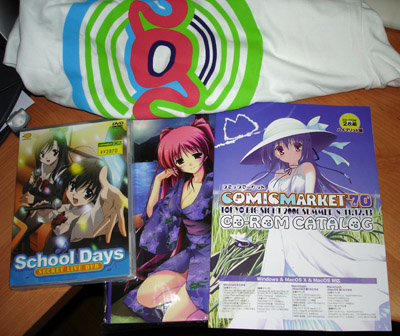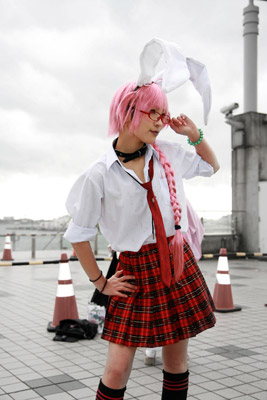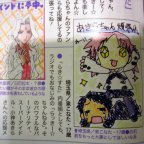Comiket: War Zone
It’s me. I’m still alive. This is not a Beowulf cluster of Linux PS3s that accidentally gained sentience in a freak thunderstorm and subsequently infiltrated the server that hosts this blog. In any case, this is (or has been) my first weekend out from boot camp and, as promised, here’s my article for the week.
I’m finally writing my Comiket article, two and a half months post incident. It’s an internet miracle.
Although this article is so late that it should given birth to two sets of octuplets by now, the delay also presented me with the opportunity to bring further introspection to the topic due to the obscene amount of time I spent staring blankly at the various concrete features that make up the pristine scenery surrounding my company line. Also, I happened to read Stalingrad by Antony Beevor while cleaning my SAR 21 rifle in camp and found it relevant to the horrors of Comiket.
Introduction
Comiket is a twice annual event that celebrates the pinnacle of moé civilization, but it is also a merciless war zone where participants fight to fuel their primal desires. Comiket old timers earn their limited edition goods just as soldiers earn their Purple Hearts: though sweat and blood (although the ratio of sweat to blood differ slightly in each case). And as time passes and the glory of the past fades into the distant memories, both the lifelong otaku and the grizzled war veteran come to the startling realization that those badges of achievements they proudly display in their bookshelves are really just cheap trinkets made in China.
Planning
Planning is an important for a successful Comiket raid, just as in any wartime operation. The first step is battle intelligence, which comes in form convenient form of the official Comiket catalogue. It provides all the necessary timings and locations you need to know, albeit in a somewhat confusing and unfriendly manner.

Catalogue on the extreme right
Of course, planning is not foolproof and reality doesn’t always play nice. As can be observed from Hitler’s mistake in his obsessive micromanagement of the Sixth Army, detailed plans that look good on paper can be completely worthless when that battalion of elite infantry on your strategic war map turned out to be a handful of Romanians with pack mules.
In the same manner, just because you have marked out and memorized the optimal routes to get yourself from booth to booth at Comiket doesn’t mean that you will actually get to buy everything you want. Sometimes it’s just impossible to get through the crowd, sometimes the doujinshi you want sells out, and sometimes the queues are just insanely long. Sticking to a plan carved in stone is dumb.
Staging
Getting to the battleground and supplying your troops is just as challenging as figuring out the best way to kill your enemies. Hardcore Comiket goers camp overnight to secure their places (it is a myth that overnight camping is not allowed at Comiket) while others take the first train there. The most important precaution for participants is to ensure that you have a proper bag that can be used to hold your expensive porn purchases without crushing them. If you end up carrying your loot in bits and pieces, you will end up moving from booth to booth at a much slower rate.
Your bag should be larger than you think you require, because Comiket is always full of unexpected booby traps that suck away your money. The Germans thought the Eastern Front was going to take a few weeks and ended up staying for two winters without any winter supplies before being encircled in the kessel of their final doom.
Battle
As you queue up around the perimeters of Tokyo Big Sight and go through last-minute checks of your equipment, mentally prepare yourself for the adrenaline rush of zero hour. When the gates open, it’s like a tamer version of the Soviet landing ships hitting the Volva’s western bank. People wearing Comiket armbands can be found every few steps directing the flow of human into and through the convention halls and ensuring that no one disrupts the preplanned pathways by taking shortcuts, just as the Soviet commissars watched over the herds of conscripts and prepared to shoot any potential deserters.
As a participant, there is only one way forward in this initial mad rush. Everyone tries to maintain a half-run walk so as to maximize speed without breaking the rules against running, and the sheer number of people around you means that it is highly impossible for you to steer yourself freely. It gets better later in the day as the number of combatants moving about drops.
Queuing and moving from booth to booth is a treacherous process that cannot be described with words alone. Proper meals are out of the question as the dining facilities in the area are overwhelmed by the demand. Much as how real wars consist of weeks of tedious marches and tasteless bread before the soldier dies from a stray bullet to the head within the first five minutes of a chaotic battle or perhaps capturing an objective or two if he’s lucky, the majority of Comiket experiences consist of standing in line for hours for a few seconds of gratification as you are finally relieved of your money. Just pray that the booth doesn’t run out of stocks just before your turn.
Eventually, the war toll adds up. In late afternoon, the convention halls become noticeably quieter and rows of war casualties line the empty spaces next to walkways. Those who failed to secure their coveted merchandises look tired and dejected, while the victors proudly showcase their hard-earned loot.
But unlike Stalingrad, for Comiket there’s always next year.
There are more to write about, but unfortunately I shall have to cut things short. In a few hours, I will be on my way back to camp to resume my patient wait for the next weekend while I perform the menial mind-numbing duties of a lowly recruit and live in the constant fear that my brain is slowly disintegrating from the lack of cognitive stimulus.












February 15th, 2009 at 3:55 pm
Wow. Nice post. Yah! NS is like that, though its tiring and tedious. You’ll miss it when you end it at 2yrs and you and your friends part ways. 3months in bmt. Endure it man. :)
February 15th, 2009 at 4:33 pm
While BMT is annoying, just be glad you are ‘C’
By the way, don’t let the first few weeks remove your natural instinct to *volunteer for cushy posts*. IT is a good place to be in, as is photography or magazine writing.
February 15th, 2009 at 4:39 pm
Excellent post. Really excellent post.
> for a few seconds of gratification as you are finally relieved of your money.
I mean, totally excellent. This is CM.
> two and a half months post incident
Except it’s not March is it? CM 75 was 12/29 and it is now 2/15, so one and half months? Or perhaps boot camp really feels like two months? ;-)
> my brain is slowly disintegrating from the lack of cognitive stimulus
You could say “fuck” all the time. ;-)
February 15th, 2009 at 4:53 pm
Good to see you stll alive man.LOL
NS look though cant ‘wait’ for mine next year.
Great post,
February 15th, 2009 at 7:31 pm
Interesting post, great loot. Aw yeah!
February 15th, 2009 at 9:52 pm
Not surprised that your description exactly matches that Lucky Star episode concerning Comiket. With Konata in battle gear, ordering her troopers Kagamin and Tsukasa around to obtain the goodies.
February 16th, 2009 at 2:20 am
How do you clean your rifle and read at the same time?
And does what happens to Comiket loot // POWs :O
“my brain is slowly disintegrating from the lack of cognitive stimulus”
– compose rhyming limericks
– mental chess
– spot patterns in wall cracks
February 16th, 2009 at 3:58 pm
Ah, the battle of Comiket…
I remember it very well…
Aside from being dark and cold…my battle was with the sun and the summer heat…
I agree Comiket is full of goodies to buy…too much I say to buy everything…
February 17th, 2009 at 4:38 pm
“Training to be soldiers… to fight for our land…”
February 17th, 2009 at 9:46 pm
Thank you for serving and keep our nation safe
for some of us to read ur interesting postings…
i suppose u oreli planned wat to do in the next 10 yrs..
As aft that time flies…
Next time u flash back its….
February 17th, 2009 at 11:06 pm
Pes C BMT is nothing, you should see how A, B & BP trained. By the way I still have 3 months left so what I can say to you is that NS will be over before you know it, its just that time will go slower as you hit the 1 year mark. And Last thing, Nice post and Great Loot
February 18th, 2009 at 3:03 am
Impressive for actually being able to acquire the loot from Comiket, goddamn that must have been a struggle. I do suggest you bring a map though and mark a preplanned path next time because often, the goods sell out much faster than expected and not all spots are in as much demand. If you get lost, oh boy… you are screwed.
February 18th, 2009 at 2:15 pm
0_o…You get to use a SAR-21?????!!!!! Thats like a Steyr AUG…! Almost. I prefer German and Belgian guns (i.e. FN P90 and the G36C)
February 19th, 2009 at 12:23 am
Mine was the last batch to use the M16. I am trained in both weapons lol, and SAR21 is considerably harder to clean and heavier.
You in Tekong or Hendon?
February 19th, 2009 at 1:31 am
Well ryuko_hikaru i think i was the batch just before yours. Lol. Also bmt m16 trained. Till now havent even touch a SAR21. Hahahah. Cause I air force. They have the best planes, but the older rifles (AR15). Lol. Apparently M16 in bmt sucks, cause mine though clean as a whistle keeps IA per shot. The AR15 i was assign in camp, no IA plus i got marksman. Who says old equipment suck. :)
February 19th, 2009 at 7:57 am
OH wow! Look at all those people! Is it possible to visit all the booths while being packed in like sardines? I guess training is required before you enter the warzone! ^^
February 21st, 2009 at 7:11 am
I must respect you for being able to navigate Comiket. The long hours of standing must be torturous. How do you do it?
~ My school is taking a trip to Japan in the summer. I’m crossing my fingers that I’ll be able to go. It’s alot of money.
February 21st, 2009 at 7:24 am
Your alive!…. that is my first post in oh so long and your a welcome sight even if your not blogging as much.
February 22nd, 2009 at 1:29 am
Heh, you gave me a good laugh with this one. I’ll keep this in mind if I ever end up at Comiket :P
February 22nd, 2009 at 10:06 am
hey DM which company are you in?
February 22nd, 2009 at 11:39 pm
That reminds me: I cannot remember where my Comiket loot went. The T2 bag’s standing on top of my 化学I and 現代漢語 though.
February 23rd, 2009 at 6:15 am
War zone….JAJAJAJA.
February 28th, 2009 at 11:01 am
Sigh its like a boxing day/black Friday massacre. Waiting in the cold rain ain’t nice either. It is serious stuff setting up camp for long lineups. Having a group is nice but you have to be organize but cellphone helps ;) but hard to hear with so much background noise!
March 3rd, 2009 at 2:40 pm
Increible!!!! Yo estoy fabricandome un NENDOROID ARTESANAL Click en Nekoboy
March 10th, 2009 at 5:16 pm
Happy POP!! Enjoy your block leave.
March 27th, 2009 at 7:30 am
be entertained
March 29th, 2009 at 2:02 am
Ah, the sad, sad fate of a Singaporean Male, NS. I see you’ve started it. Has it wrecked havoc on your social and personal life?
April 3rd, 2009 at 3:01 pm
Poor guy. He went for National Service and has dropped off the face of the earth. I don’t know about NS in Singapore, but the US Army can suck the life out of you too.
Funny though, I had just discovered this blog and was really getting into it when he had to leave for NS. I think it’s two years long.
April 3rd, 2009 at 3:22 pm
Oh, so sad. I keep checking every so often, yet nothing new from you…
I have to wonder, though. Where’d you go? This isn’t a new blog, so I doubt you’d just abandon it. Maybe the NS just takes up too much of your time? Or maybe you got sent off on some secret war and died? D:
Anyways, hurry back. I need some more pseudo-intelligence in my life. (doesn’t everyone?)
April 8th, 2009 at 3:19 pm
Though he should* be back on weekends, and there’s always the possibility of adding a twitter widget here so he can update us while AFK
All the best in there DM, though I dunno how much they will squeeze out of you for a C…
May 20th, 2009 at 10:29 pm
Wow. That’s really a lot of people. I wonder when we’ll ever have something like that in the Philippines. I’ve been trying to find people who’re willing to organize meets like that. Maybe one day, I can attend the comiket. *envies*
December 7th, 2009 at 4:21 pm
Question!
Hey, I’m 15 years old, and this winter I’m heading to Japan to visit friends again. This yeah, I have the privilege to to C77. However, me being of a young age, will they not let me in? Do they ID check or anything? Or is it based all on the honor system? I know there is a lot of H stuff, but there are some Artist’s works which I want to find too.
Also, does it cost anything to get in? Or is it just walk-in open gate?